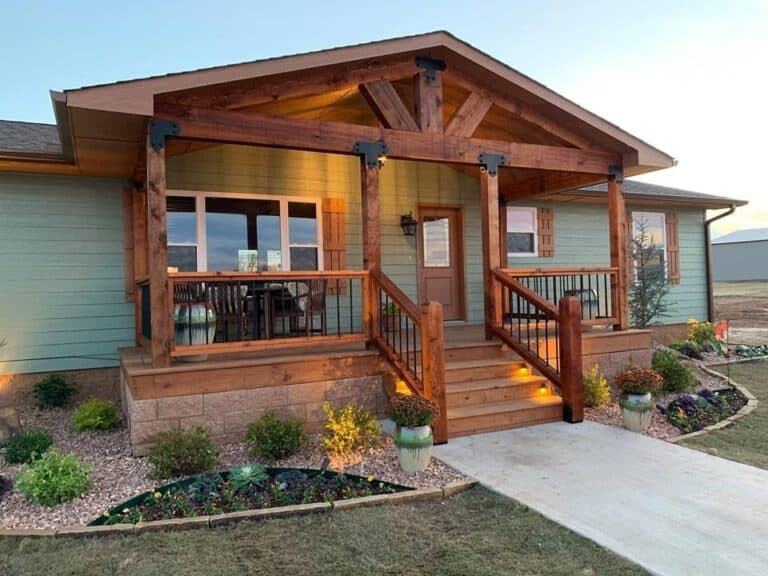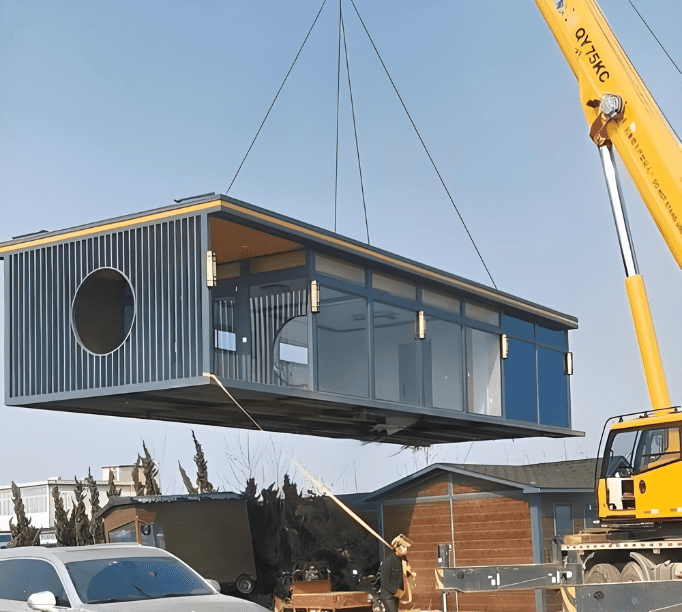Let’s be honest—modular homes are great, but sometimes they can look a little… well, “modular.” You know, like they belong in a parking lot, next to a row of storage containers. But hey, we’re not here to judge—just to help you make your home look as good as it feels.
The good news? You don’t have to tear down walls or spend a small fortune to make your house feel like a custom masterpiece. With just a few simple upgrades, you can add style, character, and curb appeal—without the stress or the bank-breaking cost.
In this guide, we’ll walk you through practical, affordable ways to boost your home’s look, whether you’re working inside, outside, or both. Ready to turn your “box” into a beautiful home? Let’s get started.
What’s Expected in This Blog:
Why Do Some Modular Homes Look “Too Plain”?
Have you ever looked at your modular home and thought, “Why does it feel… unfinished?” You’re not the only one. Many modular homes—especially entry-level models—can appear flat and generic from the outside. The shape is simple. The siding looks the same on every wall. There’s no contrast, no detail, nothing that makes the house feel unique.
From the street, it might look more like a utility box than a home. No front porch to welcome you in. No trim to frame the windows. No variation in the roofline to break up the shape. Just one long, unbroken surface.
But this doesn’t mean your home has to stay this way.
In fact, the clean lines and simple structure of a modular home make it the perfect blank canvas. Think of it like this: you already have the foundation and walls—now it’s time to add the personality. Imagine what a few changes could do. A wooden front porch with a small roof overhang. Dark-trimmed windows set against light siding. Stone skirting along the base. Suddenly, your home doesn’t just function—it feels welcoming, warm, and styled.
The difference isn’t in rebuilding. It’s in reimagining.
And that’s exactly what we’ll walk through in the next sections: the specific ways you can transform how your modular home looks and feels, step by step.
What Are the Most Effective Ways to Improve a Modular Home’s Exterior?
You don’t need to change everything to make a modular home look better. In fact, the biggest improvements often come from just a few targeted upgrades. Below are some of the most effective exterior changes that create real visual impact—without rebuilding from the ground up.
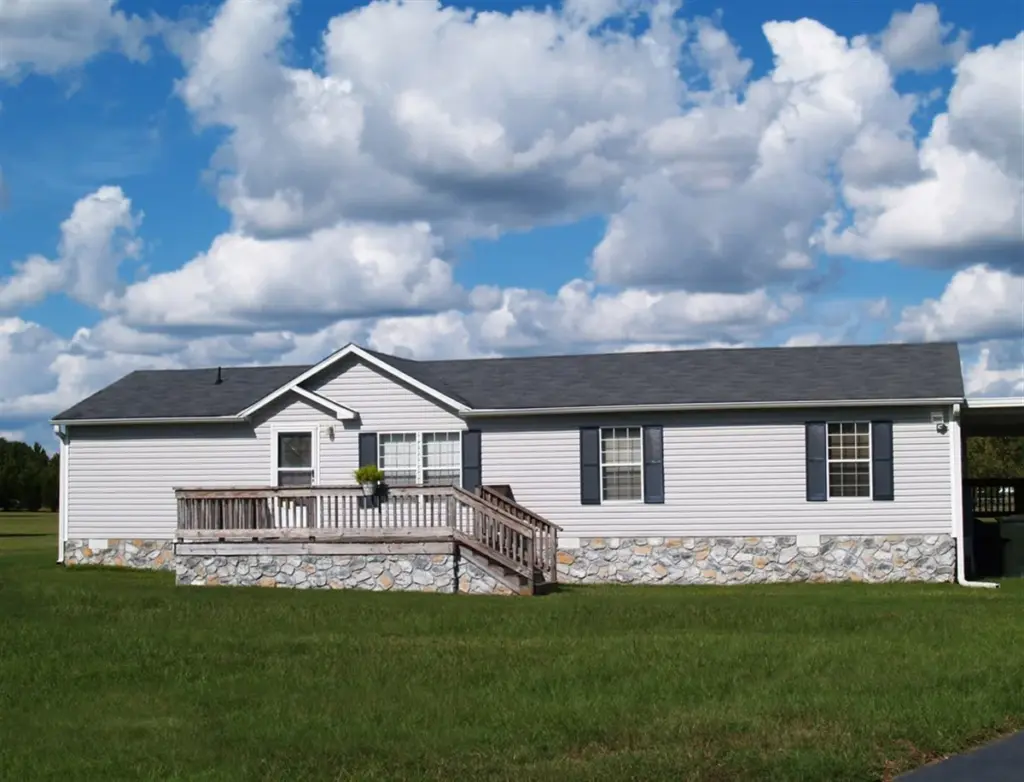
1. Add or Redesign the Front Porch
Many modular homes have no porch at all, or just a small set of stairs. This makes the front feel abrupt or unfinished.
Even a small porch—with columns, a railing, or a covered roof—can transform that first impression. Picture walking up to your home with a timber-framed awning above the door, a warm light hanging overhead, and a few potted plants framing the entrance. Suddenly, it doesn’t feel like a temporary structure—it feels permanent and welcoming.
2. Upgrade the Siding with Texture and Contrast
Plain vinyl siding in a single color tends to flatten the entire look of the home. Swapping it out for materials with texture—like fiber cement, metal panels, or wood-look composites—can make a huge difference.
Even if you don’t replace all the siding, adding contrast helps. Try a darker color on the lower half of the exterior, or use vertical panels on one side of the home to break up the horizontal lines. It gives the home depth, character, and modern appeal.
3. Extend the Roofline or Add Overhangs
One reason modular homes often look boxy is the flat or shallow roof profile. Adding overhangs, or building a deeper eave around the edge, helps soften those hard lines.
These changes don’t have to be structural. In many cases, decorative overhangs or false gables can be attached to the exterior frame. The result? A more dynamic shape—and a house that looks built to last.
4. Frame the Windows and Doors
Standard modular windows can look lost in a large blank wall. Surrounding them with bold trim, shutters, or modern metal framing helps them stand out.
The same goes for the front door. A contrasting color, a larger casing, or even a different material can turn a basic entrance into a visual feature. Imagine a deep charcoal door framed in white trim—clean, simple, striking.
5. Add One Signature Feature
Sometimes one bold element can lift the whole exterior. That might be:
- A wood beam trellis across the front
- A vertical slat privacy wall beside the door
- A stone or metal accent panel that wraps around a corner
These additions draw the eye and break up the uniformity of the facade. Think of them as your home’s signature—something small that makes a big statement.
Can Landscaping Really Make That Much of a Difference?
Absolutely—and probably more than you think.
When you first picture a home, it’s rarely just the walls and the roof. What you remember is the whole setting: the curve of a path, the trees around it, the lights on at dusk. A modular home with plain siding and simple lines can feel cold on its own. But place it within a thoughtful landscape, and suddenly it looks grounded. Intentional. Like home.
Let’s say your house sits in an open lot. No trees, no fence, just a gravel path to the front door. Now imagine lining that path with native plants, placing a small wooden bench near the steps, and running soft lighting along the edge. The house hasn’t changed—but the way it’s perceived has changed entirely.
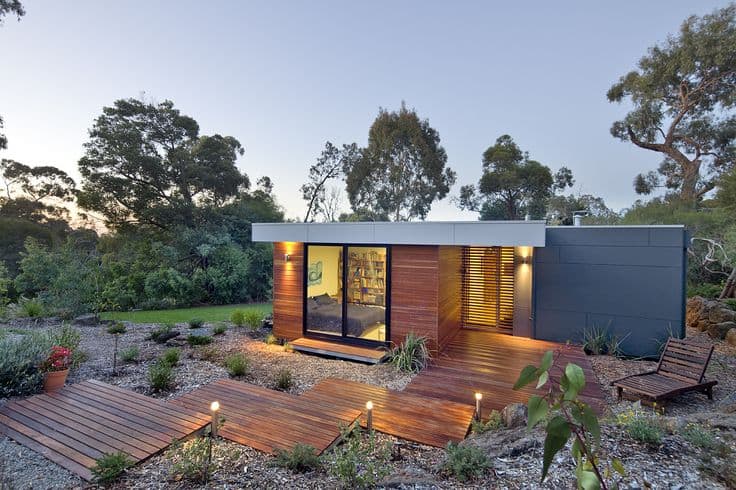
Landscaping creates frames, depth, and balance. It helps break up the boxy outline of the home, softens harsh angles, and draws attention to your favorite features—like a porch or new siding. And it doesn’t have to be complicated. In fact, the best improvements often come from just a few smart choices.
For example:
- Planting a single tree off-center in the front yard can create symmetry with an entry porch.
- A narrow flower bed along the base of the home adds color and texture, hiding the foundation line.
- Vertical elements, like trellises or tall grasses, help “lift” the visual weight of a one-story home.
- Even a gravel path with stepping stones adds rhythm and leads the eye.
One of the most overlooked tricks? Lighting. Solar-powered path lights, a wall-mounted sconce by the door, or even string lights over a sitting area can completely change the mood at night. Your home goes from “barely there” to “warm and inviting”—without touching the building itself.
So yes, landscaping matters. A lot. It’s not just about plants—it’s about how your home sits in the world around it. And often, it’s the easiest place to begin.
What Interior Changes Also Improve the Overall Feel?
When a home looks good on the outside but feels disconnected inside, that contrast can be jarring. You might not notice it right away—but maybe you’ve walked in, looked around, and felt like something didn’t match. The siding says “modern cabin,” but inside it still feels like a temporary rental.
That’s where subtle interior upgrades make a big difference. Not because you’re chasing trends, but because you want the inside and outside of your home to speak the same language.
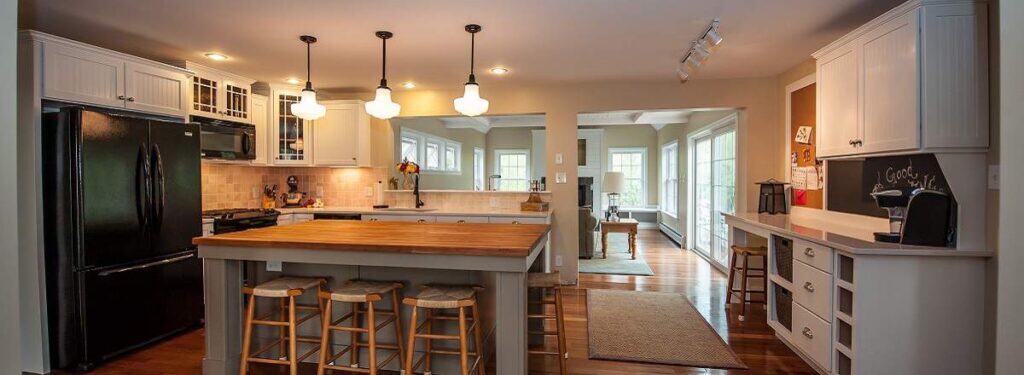
Start with light. Natural light is one of the most powerful design tools, and modular homes sometimes come with small or poorly placed windows. If you’ve already upgraded your windows from the outside, make sure they work for your interior too. Are your curtains always drawn? Are the frames still standard white plastic? A simple swap—larger panes, clean trim, lighter fabric—can open up the entire room.
Next, look at surfaces. Floors, walls, cabinets—these are what you see every day. If they still feel “builder-basic,” they’ll keep pulling your home back into that generic category. You don’t have to rip everything out. Sometimes it’s just painting cabinets a deep green, or laying a new rug with a strong pattern that defines the space.
Also think about flow. Does your space feel open and intentional? Or does it still follow the “hallway-box-hallway” layout that many modular homes start with? You might not be able to move walls, but you can rearrange furniture to create better sight lines, define zones, and make the home feel more spacious—even if the square footage stays the same.
Texture matters too. Wood accents, linen curtains, matte finishes—all these things add warmth and visual interest. If the exterior now feels grounded and natural, but the inside is glossy and cold, the disconnect will be obvious.
Finally, consider how your personal style shows up. What you hang on the walls, the tones you repeat from room to room, the small things like switches or handles—they all speak. If they align with the feel you’re building outside, your home starts to tell one cohesive story.
How Much Do These Improvements Cost?
It’s the question that always comes next: How much will this actually cost me? The truth is, you have more control over that answer than you might think.
Improving the look of your modular home doesn’t have to mean a massive investment. You can start small and still make a big impact. Or, if you’re ready to go all in, there are higher-end upgrades that can truly transform the home. Let’s break it down.
Low-Cost, High-Impact Changes
If your budget is tight, focus on the small things that change how the home feels at first glance. Paint is a powerful tool—whether it’s a new front door color, window trim, or siding refresh. Adding solar path lights, planting a few trees or shrubs, or even hanging a set of outdoor string lights can completely shift the vibe. These changes often fall in the $100–$1,000 range.
They’re not dramatic in labor or cost, but they speak volumes.
Mid-Range Upgrades with Visual Payoff
With a bit more flexibility, you can look into things like adding a porch overhang, upgrading your siding material on one side of the home, or installing larger windows in key rooms. These upgrades tend to cost between $2,000–$10,000, depending on size and materials.
But the payoff is visible from the street—and if you ever resell, from the listing photos too.
This range is also where smart planning matters. A well-designed $5,000 porch can do more for curb appeal than a $10,000 full re-siding job done without contrast or framing.
Higher-End Transformations
If you’re treating this as a long-term investment, and you’re ready to commit to a more dramatic transformation, a full siding replacement, custom rooflines, or modular extensions may be on the table. These projects can range from $10,000 to $50,000+, depending on complexity, finishes, and labor.
That sounds like a lot—and it is—but consider what it buys: a modular home that doesn’t just blend in but stands out. One that looks custom-built, not factory-made.
So… Where Should You Start?
Start where the impact meets your reality.
If all you do this year is add a porch light, repaint the trim, and put in a few plants, you’ve already shifted the tone of your home. If next year you swap siding or add a window, even better.
It’s not about doing everything at once—it’s about knowing which change matters most to you, and doing that well.
Can I Do It Myself or Should I Call a Pro?
That depends—not just on your skill level, but on what kind of change you’re planning to make.
What You Can Likely Do Yourself
If you’re handy and motivated, there’s a lot you can tackle. Painting trim, building garden beds, adding solar lights, changing hardware on doors or windows—these are low-risk, high-impact updates that don’t require permits or special tools.
Even building a small porch or overhang is possible for experienced DIYers, especially if you’re using prefab kits or working from clear plans. The key is preparation: double-check your local codes, measure carefully, and know when to stop if things get too technical.
Landscaping also offers plenty of DIY opportunities. Whether it’s laying gravel, planting trees, or assembling a wooden bench, these projects can dramatically improve your home’s feel without touching the structure.
But not everything should be a weekend job.
When It’s Smarter to Bring in a Pro
If you’re replacing siding, modifying the roofline, changing window sizes, or attaching structural additions, it’s time to work with a contractor. Modular homes have different framing systems than site-built homes, and improper work can lead to issues with water sealing, insulation, or even structural integrity.
Professionals also help with long-term planning. Maybe you want to replace your siding now, but leave space for a porch later. A good builder or modular upgrade specialist can help you phase it properly, so you’re not undoing your own work six months down the road.
And in some cases, working with a pro can actually save money—by avoiding mistakes, rework, or compliance problems.
How Do You Know What’s Right for You?
Start by asking two questions:
- Will this change touch the structure of the home?
- Am I confident in both the design and the execution?
If the answer is yes to both, you may be fine on your own. If not, or if you simply want peace of mind, getting a quote from a reputable modular specialist is a smart first step.
You don’t have to commit—you just have to ask. Knowing your limits is part of good design. So is knowing when to bring in someone who’s done it a hundred times before.
Where Can I Find Inspiration and Trusted Solutions?
Sometimes, the hardest part isn’t deciding what to do—it’s knowing where to begin. If you’re starting to see the possibilities for your modular home, the next step is finding real-world inspiration and people you can trust to help you get there.
Start simple.
Look at homes that speak to you—not just modular ones. Instagram, Pinterest, and design blogs are full of ideas that can be adapted to your space. Save what catches your eye. You don’t need a complete plan right away. You just need patterns—colors you’re drawn to, shapes that feel right, materials that make sense for your environment.
But don’t stop at images.
Try to look behind the photo. Was that siding part of the original build, or an upgrade? Is that porch custom-built or modular? The more you start noticing these details, the more confident you’ll feel about what’s possible.
When it comes to execution, not all solutions are equal.
The best partners don’t just sell you materials—they understand the structure of modular homes, how to work within your home’s layout, and how to make it look like something more than a box. Whether you’re buying siding, planning a roof extension, or adding a façade element, working with people who know this type of construction makes everything smoother.
Once you have the vision, here’s how to make it real.
If you’d rather skip the trial and error, look for specialists who offer modular-friendly upgrades—materials designed with prefabrication in mind, structural elements that install cleanly, and design advice that fits the scale of your home. Companies like SteelPRO PEB, for example, don’t just supply parts—they design and build systems that work with the homes you already have.
At the end of the day, the right inspiration gets you excited. The right partner gets it done. And when you have both, that’s when your modular home really starts to become your dream home.
Conclusion: Your Modular Home’s Potential is Within Reach
You’ve learned that your modular home doesn’t have to stay plain or basic. With the right upgrades, you can transform it into a stylish, functional, and truly personalized space—whether you’re looking to enhance its exterior, interior, or both.
But here’s the key takeaway: it doesn’t have to be overwhelming or expensive. The improvements we discussed are not just ideas—they are actionable steps that can immediately make your home feel more like yours. From simple DIY tweaks to thoughtful professional upgrades, each change you make adds to the overall comfort and visual appeal of your space.
The best part? You don’t have to do it all at once. Start small, with one change at a time, and watch as your home evolves. As you move forward, you’ll see the potential of modular homes unfolding right before your eyes.
The journey of transforming your modular home is as much about personal expression as it is about practicality. And you’re now equipped with the tools, ideas, and confidence to take that first step.
So, what’s stopping you? Whether you’re ready to tackle a project on your own or need professional support, there’s no better time to begin than now. Your dream home is closer than you think. Let’s get started.
